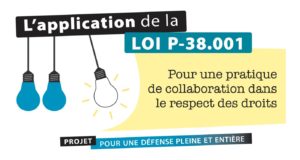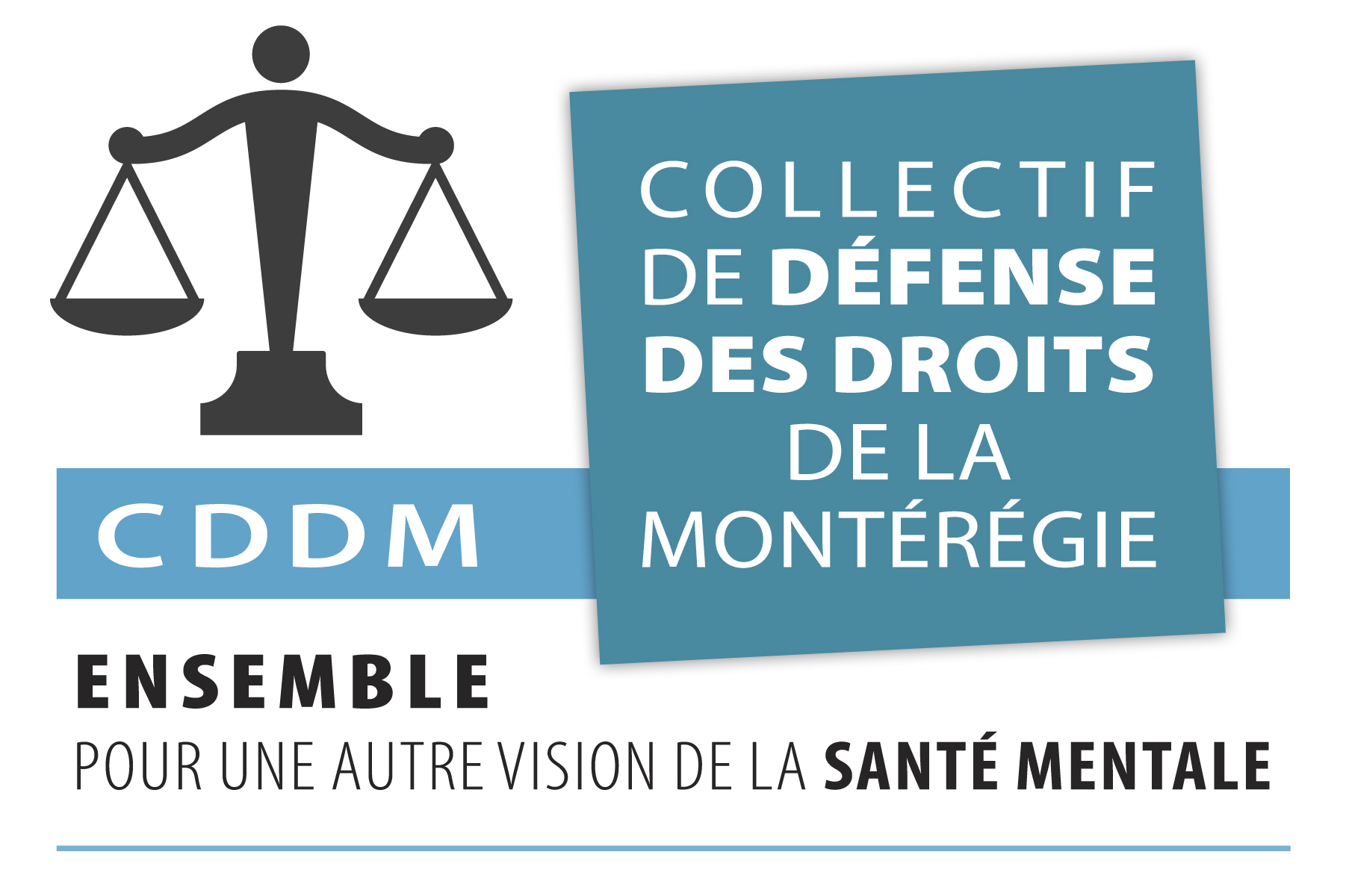Exceptions
Numerous exceptions that target an individual’s mental state infringe upon fundamental rights. Various laws, legal provisions and the power of the courts can serve to curtail freedom, force medical treatment, and legitimize the use of confinement and physical or chemical restraint. Such measures contravene both the Québec Charter of Human Rights and Freedoms and the Canadian Charter of Rights and Freedoms, particularly the principle of individual inviolability, the right to integrity and the right to liberty. In theory, these are last-resort measures that should only be applied under extreme circumstances. The list below presents the topics that drive our actions in terms of the risks and significant impacts of these practices on vulnerable people.

Court-ordered treatment can force someone to receive care (e.g. pharmacological treatment, electroconvulsive therapy) or be subject to residential placement against their will. It is granted by the Superior Court, generally for a period of two, three, or even five years, with no opportunity for review. This last point is particularly draconian, not only since a person’s situation can change during such an extended period, but also in light of the many negative impacts of psychotropic drugs.
People very often face this legal procedure without being informed, without being heard by the judge who is to decide their fate, and even without legal representation.
The key criteria used by the court to order treatment are the person’s inability to make informed decisions regarding their own care, and the demonstrated benefits of treatment compared to the risks of its imposition.
This practice violates the fundamental rights to freedom, individual inviolability and integrity. It also violates the right to consent to care (Act Respecting Health Services and Social Services), the right to legal representation, and the right to be heard in court (Civil Code of Québec).
Free translation of an excerpt from the original French text. Source: AGIDD-SMQ (Association des groupes d’intervention en défense des droits en santé mentale du Québec)
Have you been subject to court-ordered treatment? Want to exercise your rights? Contact us.
We are currently part of a research project into court-ordered treatment in Montérégie in association with.
For more information, see our Documents page.
The many faces of social control: court-ordered treatment in the Longueuil judicial district
A research initiative that holds promise for the defense of fundamental rights
In 2018–2019, the CDDM approached researcher Emmanuelle Bernheim and UQAM’s Service aux collectivités (SAC) about working together on a project about court-ordered treatment.
Work began in fall 2019 with the SAC’s steering committee, at the time composed of Ms. Bernheim, development officer Geneviève Chicoine (SAC), and Azélie Rocray and Laurence Boucher-Poirier (CDDM). Mr. Boucher-Poirier was later replaced by David-Alexandre-Grisé.
We then drafted the research design and presented it to UQAM’s Programme d’aide financière à la recherche et à la création (PAFARC). It was a source of pride that our project was selected with a mention of excellence and granted sufficient funding for its entirety.
In January 2020, we hired a master’s student and the project officially got underway. The first step was to approach the Longueuil courthouse to request access to treatment orders, which were to be our main data source.
This process was unfortunately short-lived, since the advent of COVID-19 in March 2020 rendered the courthouse inaccessible, effectively putting the project on hold. Things have since resumed.
The project has a twofold aim: one, to document the various practices regarding court-ordered treatment at two regional hospital centres, Hôpital Pierre-Boucher (CISSS de la Montérégie-Est) and Hôpital Charles-Lemoyne (CISSS de la Montérégie-Centre); and two, to observe how these practices impact the rights of those who have been subject to court-ordered treatment. The research is premised in our observations that respect for people’s rights can vary from one hospital to the next in Montérégie, and that not all health professionals completely understand the treatment order’s terms of application.
Our working hypothesis is that these practices signal differing interpretations of individual rights that are likely to be reflected in the request for court-ordered treatment.
Our approach
Given that the Longueuil courthouse is the sole entity to tally the practices at both hospitals (each of which answers to a different CISSS), our observations drawn from this single judicial district will allow us to document any differences in practice and culture, as well as shedding light on the amplitude of these differences both in our own jurisdiction and across Québec.
Defining the issue:
In light of these considerations, our aims are as follows:
Document the practices at the Montérégie-Est and Montérégie-Centre CISSSs
Compare these practices to extract their differences and similarities
Document legal practices in the Longueuil judicial district
Establish the connection between hospital and judicial practices
Our working hypothesis is to the effect that differences in practices between the two CISSSs signal divergent interpretations of the rights of the persons concerned, a situation that is likely to be reflected in the nature of any treatment orders requested and subsequently granted by the court.
Methodology
Our approach will involve accessing and systematically analyzing court records, including health institution requests, information on the hearings, and the treatment orders granted. Beyond these elements, we cannot say precisely what we will be allowed to access, since some information is confidential. Psychiatric reports will be sealed and therefore inaccessible, but certain other documents may be available.
At this stage, we know that we will be able to collect the following:
To document hospital practices
- The requesting institution
- The nature of the request (who made the request, type of treatment requested, residential placement or not, use of police services or force, duration requested, etc.)
- Information on the procedure (compliance with strict deadlines, notification delivered by hand, request for a waiver of notice/of testimony, etc.)
- Legal arguments (proof of incapacity to consent to care, categorical or unjustified refusal, need for care, etc.)
To document court practices
- Information on how the hearing went (number of witnesses and whom, whether the person in question was present or not, represented or not, etc.)
- Legal arguments (proof of incapacity to consent to care, categorical or unjustified refusal, need for care, etc.)
- Information on the procedure (compliance with strict deadlines, in-person notification, request for exemption from notification or testimony, etc.)
- Outcome (request granted or not, nature of the treatment order, duration, etc.)
To better understand the context, we will also document the following:
- The profile of the person concerned (gender, age, employment, housing, family situation, etc.)
- The facts leading up to the request (crisis, hospitalization, pressure from relatives, job or housing loss, etc.)
Three years of records (2016, 2017 and 2018) will be analyzed; justice department figures suggest that this will amount to some 250 files. We should be able to compile all content, depending on the number of documents in each file. In the event of too many documents or more files than expected, we will proceed by random sampling.
The research will employ a mixed-method (qualitative/quantitative) approach, drawing on data from the categories above to present a comprehensive overview. This will include producing statistics on each element studied, such as the nature of the request (treatment only, residential component, etc.), compliance with the procedure (deadlines, waiver requests, etc.), and so on. We will also use document excerpts to analyze the discourses specific to each environment, legal and medical. For this component, NVivo software will be used to quantify, organize, analyze and find insights in the qualitative data.
The Act respecting the protection of persons whose mental state presents a danger to themselves or to others, commonly known as P-38, allows someone who has not committed a crime to be detained in a health institution and thus deprived of their liberty.
This law is said to be “exceptional” since it contravenes the fundamental individual rights to freedom, integrity and inviolability.
The sole condition for confining someone in an institution against their will is dangerousness, i.e. if their mental state is seen to present a grave and immediate danger to either themselves or others.
There are three types of institutional confinement: preventive confinement, which allows someone to be hospitalized against their will, without a court order, for up to 72 hours; temporary confinement, which is ordered by the court for the purpose of making a person who refuses psychiatric assessment to undergo such an assessment; and court-ordered confinement, which forces someone to be hospitalized for a period that generally varies from 21 to 30 days.
Free translation of an excerpt from the original French text. Source: AGIDD-SMQ (Association des groupes d’intervention en défense des droits en santé mentale du Québec)
Have you been subject to institutional confinement? Do you want to exercise your rights? Contact us.
The CDDM is currently working with the CISSS de la Montérégie-Est to provide access to justice to those who have been subject to institutional confinement so that they are better informed of their rights and thus able to better defend themselves.
For more information, see our Documents page.
Article 118.1 of the Act respecting health services and social services states: “Force, isolation, mechanical means or chemicals may not be used to place a person under control in an installation maintained by an institution except to prevent the person from inflicting harm upon himself or others. The use of such means must be minimal and resorted to only exceptionally, and must be appropriate having regard to the person’s physical and mental state.”
As a minimum criterion, control measures such as seclusion or restraint must only be used when someone is at an extreme risk of inflicting harm upon themselves or others, and not as a disciplinary measure or punishment.
Control measures such as seclusion and physical or chemical restraint are issues of concern, not just for people living with a mental health disorder, but also the elderly, people with functional limitations and young people, particularly in rehabilitation centers.
- Seclusion consists in confining someone, for a determined period, to a room from which that person cannot exit freely.
- Physical restraint consists in preventing or limiting a person’s freedom of movement through either physical force or mechanical devices, or (in the case of someone with a disability) by depriving them of the means they use to compensate for their disability.
- Chemical restraint consists in using medication to limit someone’s capacity to act.
Free translation of an excerpt from the original French text. Source: AGIDD-SMQ (Association des groupes d’intervention en défense des droits en santé mentale du Québec)
Have you been subject to control measures? Do you want to exercise your rights? Contact us.
Since the historic victory of the class action against Hôpital du Suroît in Valleyfield, May 15 has become the National Day of No to Control Measures.
For more information, see our Documents page.

This project stems from a partnership agreement between the CDDM and the mental health branch of the CISSS de la Montérégie-Est (CISSS ME).
The project began in 2017 and has been implemented in three CISSS ME hospitals with a view to reaching people who have been confined in psychiatric units against their will.
Objectives
- Systematically provide information on legal rights and remedies to persons who have been served a request for confinement in an institution.
- Allow those wishing to contest their confinement to be represented by a lawyer.
- Accompany people to court and conduct meetings at the hospital, as needed.
Procedure
- The staff member who is in charge of the psychiatric unit assigns a number to the person who is the subject of the request for confinement.
- This information along with the person’s gender is faxed to the CDDM.
- The CDDM calls the unit to establish contact with the person.
- There are now three possibilities: the person either agrees to speak to us, refuses or is unavailable.
A successful undertaking
- We established a collaboration protocol with the CISSS ME that allows us to systematically and confidentially contact people who are the subject of a request for confinement in an institution.
The implementation of such a mechanism between the various CISSS ME and CDDM stakeholders is a new approach in the relations between an advocacy group like ours and a health institution. - The intervention reassures patients, who feel listened to and heard, as well as able to ask the questions that concern them and receive a level of support that surpasses their expectations.
Results
Since the project’s launch and systematization, nearly half of our health and social services interventions have been carried out exclusively in this framework. The issues addressed by the project are central to our concerns and are the driving force behind our actions. In the longer term, we hope to be able to extend this framework across the region, though this will depend on being able to secure recurring support. The fact that our approach has served as a model and has been partially reproduced elsewhere in the region augers well.
The project has provided us with a remarkable window onto just how issues in the application of P‑38 are by no means limited to the health sector; indeed, they also extend to the legal system, crisis centres and law enforcement—environments across Montérégie where cultures and practices may differ. In short, we can use our observations to report on and note the particular abuses resulting from the application of P-38 and propose other means of dealing with them.
Lastly, the project’s launch has brought us into contact with a new cohort of actors who have bolstered our credibility in our specific role, thus allowing us to better represent those who are directly affected. More than anything, we help clarify things for, listen to and empower people at a time when they most need it, i.e. when they at their most vulnerable due to a particular condition or situation. We will keep working to ensure that this “exceptional” mechanism is worthy of the name!
